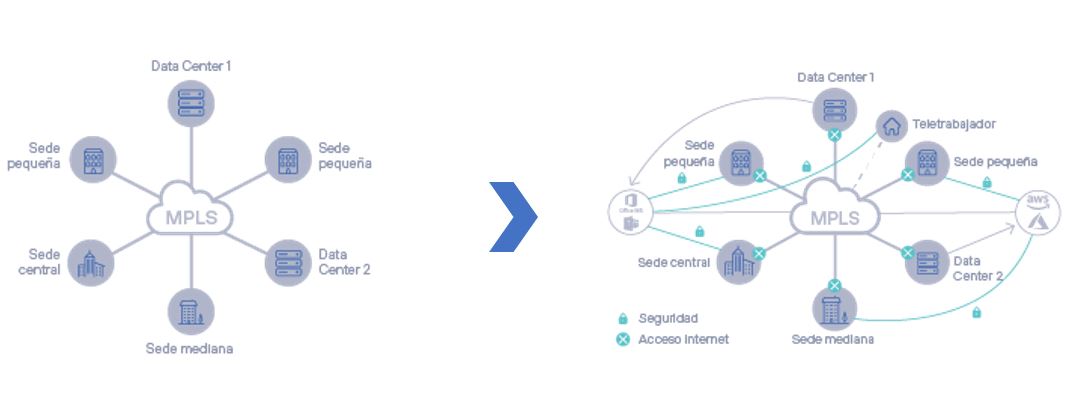Key to business digitalisation: the convergence of connectivity and Cyber Security
Digitalisation is essential to boost the competitiveness of businesses in a constantly changing environment. It improves efficiency and productivity and facilitates adaptation to new markets and changing customer needs. It also enables companies to embrace work trends such as hybrid and mobile working.
However, to protect data, digital assets, devices, employees, and customers, it is essential to consider Cyber Security from the beginning of any digitisation process.
Cyber security is therefore key to any business strategy, securing financial results and business continuity, and strengthening the trust of customers and business partners.
Evolution of business applications
The applications used by companies and organisations have evolved in recent years due to changing needs and demands.
Whether they are order management applications, billing tools, sales, or stock management, among many others, enterprise applications have evolved from an initial approach where they were consumed directly from the customer's network, with little bandwidth, to models where they are accessed over the Internet, either by deploying them in the public cloud or as a service, which has led to a significant increase in bandwidth consumption.

The exponential increase in remote working in enterprises, having to securely access the enterprise network from anywhere.
Convergence between connectivity and cyber security
These changes in the consumption model directly affect both connectivity architecture and enterprise security:
- Connectivity: Centralised or low-bandwidth Internet access is no longer sufficient, as this application consumption model requires higher access performance and stability. In addition, this increased bandwidth consumption also affects intra-site communication, i.e., the LAN and WLAN connectivity of enterprises.
- Security: when opening the sites to the Internet and allowing remote user connectivity, it is necessary to protect both the users at the site and the assets deployed at each of the sites (storage, legacy applications, documentation, etc.), as well as the endpoints that are connected remotely.
Initially, these two challenges were approached independently of each other:
- On the one hand, connectivity solutions (SDWAN, dedicated Internet, tunnels, WiFi, switches, etc.) were addressed.
- On the other hand, security solutions (large perimeter firewalls, DNS filtering, etc.).…).
This type of enterprise solution has led to connectivity and security being seen as two solutions in different verticals, requiring very close coordination.
This approach adds complexity to customer management, leads to customer service failures due to inconsistent configurations, and does not allow for full-service visibility. Ultimately, it affects business performance.
A comprehensive solution: flexWAN
To solve this problem, at Telefónica Tech we have developed convergent connectivity and security services that allow:
- Adapt our clients' networks to the new connectivity needs both in the WAN component and in LAN/WLAN.
- Guarantee the security of our customers' employees and assets.
- Incorporate everything into a single management model for changes, incidents, and monitoring.
Our flexWAN solution is the converged connectivity and security service that:
Improves application performance
Both legacy applications (deployed in the customer's datacenter or offices), cloud applications or applications as a service. This is done through:
- Using multiple links at each site, to use the one that performs best for each application.
- Prioritisation of applications that are critical to the business (order management, ticketing tools...) and de-prioritisation of others (video on demand consumption, social networks...).
- Integration of WAN, LAN and WLAN for convergent configuration and monitoring.
Incorporates the perimeter security layer at the head office
It is necessary to protect access to the head office by incorporating Internet links at all sites, and this requires the incorporation of Next Generation Firewall (NGFW) capabilities. In addition to static rules at the interface level, subnets, etc., it is possible to incorporate security rules at the application and user group level.
In addition to these capabilities, encrypted traffic inspection (SSL) is used to analyse and block traffic that may be malicious, through:
- Intrusion prevention engines (IPS): analysis of traffic patterns that are categorised as malicious, to block them before an attack can take place.
- Antivirus: identification of possible files containing malware, to prevent the compromise of on-site computers
- Sandboxing: execution of suspicious files in secure environments, to ensure that as yet unidentified malware cannot affect our customers.
- And other capabilities such as data leak prevention (DLP), security on servers with an Internet presence (DMZ), rendering of suspicious files (CDR)…
Protects user browsing
Incorporate capabilities to protect our customers' employees against attacks on Internet browsing, blocking malicious pages, pages with specific content (porn, terrorism...) or by region/country, or even website and video content (DNS Filtering, Web Filtering, Content Filtering, Video Filtering, Search Filtering).
In addition, we provide all these capabilities in a convergent manner providing our customers with a comprehensive service model that:
- Is integrated with Telefónica's connectivity: the flexWAN service is compatible with both private connectivity (MPLS) and public connectivity (Internet).
- Unifies the management of incidents and changes in connectivity and security: a single support and customer service team for any incident or request for a change in the service, with knowledge of connectivity and security.
- It brings together the monitoring and administration of the network (WAN, LAN and WLAN) and security in a single customer portal.
Conclusion
While digitalisation improves business efficiency and productivity and makes it easier to adapt to new markets and changing customer needs, Cyber Security plays a key role in addressing any digitalisation process to secure business operations, processes and outcomes.
Our flexWAN solution integrates connectivity and security services that adapt customers' networks to their new connectivity needs, while protecting their communications and the security of their employees and digital assets.
This solution, based on a converged approach between connectivity and security, improves application performance, incorporates perimeter security layers, and provides businesses with more efficient management and greater protection of their digital realm.
Image: rawpixel.com / Freepik.
 Hybrid Cloud
Hybrid Cloud Cyber Security & NaaS
Cyber Security & NaaS AI & Data
AI & Data IoT & Connectivity
IoT & Connectivity Business Applications
Business Applications Intelligent Workplace
Intelligent Workplace Consulting & Professional Services
Consulting & Professional Services Small Medium Enterprise
Small Medium Enterprise Health and Social Care
Health and Social Care Industry
Industry Retail
Retail Tourism and Leisure
Tourism and Leisure Transport & Logistics
Transport & Logistics Energy & Utilities
Energy & Utilities Banking and Finance
Banking and Finance Sports
Sports Smart Cities
Smart Cities.jpg)

.jpg)




